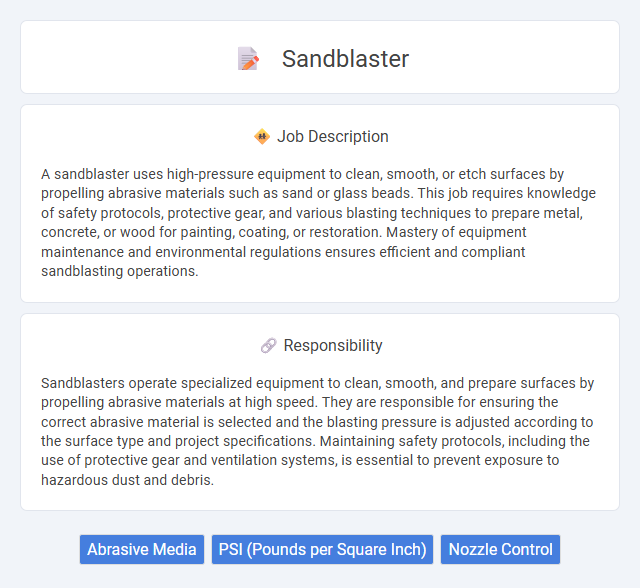
A sandblaster uses high-pressure equipment to clean, smooth, or etch surfaces by propelling abrasive materials such as sand or glass beads. This job requires knowledge of safety protocols, protective gear, and various blasting techniques to prepare metal, concrete, or wood for painting, coating, or restoration. Mastery of equipment maintenance and environmental regulations ensures efficient and compliant sandblasting operations.
Individuals with strong physical endurance and good respiratory health are more likely to be suitable for sandblaster jobs, as the work involves exposure to dust and requires manual labor. Those with pre-existing lung conditions or sensitivity to airborne particles may find this job unsuitable due to increased health risks. Proper protective equipment might improve safety but may not fully mitigate the hazards for all workers.
Qualification
A skilled sandblaster requires expertise in operating high-pressure abrasive equipment to remove paint, rust, and contaminants from various surfaces, ensuring preparation for coating or welding. Essential qualifications include proficiency in safety protocols, knowledge of abrasive materials, and the ability to interpret technical specifications for surface treatment. Certification in abrasive blasting, physical stamina, and attention to detail significantly enhance job performance and compliance with industry standards.
Responsibility
Sandblasters operate specialized equipment to clean, smooth, and prepare surfaces by propelling abrasive materials at high speed. They are responsible for ensuring the correct abrasive material is selected and the blasting pressure is adjusted according to the surface type and project specifications. Maintaining safety protocols, including the use of protective gear and ventilation systems, is essential to prevent exposure to hazardous dust and debris.
Benefit
Sandblasters likely experience improved surface preparation that enhances the adhesion of coatings, leading to prolonged durability of treated materials. This job may offer opportunities to develop specialized skills in abrasive techniques, which are valuable in construction, automotive, and manufacturing industries. Workers in this role might also benefit from relatively high demand, potentially resulting in stable employment and competitive wages.
Challenge
Sandblaster jobs likely involve significant challenges due to the need for precision and safety when handling abrasive materials at high pressure. Workers probably face risks related to exposure to dust and particles, requiring strict adherence to protective measures and proper equipment use. Mastery of controlling the blasting process to avoid surface damage while achieving the desired finish seems essential for success in this role.
Career Advancement
Sandblasters with expertise in surface preparation techniques can advance to supervisory or project management roles in industries such as construction, shipbuilding, and manufacturing. Gaining certifications in safety protocols and equipment operation enhances career prospects and salary potential. Continuous skill development in abrasive materials and advanced blasting technologies leads to specialized positions in industrial maintenance and restoration.
Key Terms
Abrasive Media
Sandblasters specialize in surface preparation by propelling abrasive media at high speeds to clean, smooth, or etch materials such as metal, concrete, or glass. Common abrasive media include silica sand, aluminum oxide, glass beads, and garnet, each selected based on hardness, particle size, and application requirements to achieve optimal surface finish and material removal. Proper handling and disposal of abrasive media are essential to ensure workplace safety and environmental compliance in industrial blasting operations.
PSI (Pounds per Square Inch)
Sandblasters operate equipment that uses high PSI, typically ranging from 30 to 100 PSI, to propel abrasive materials at surfaces for cleaning or finishing. Maintaining optimal PSI ensures efficient removal of rust, paint, or contaminants without damaging the substrate. Precision in controlling PSI levels is critical to achieve desired surface profiles and maintain safety standards.
Nozzle Control
Precise nozzle control is critical in sandblasting to achieve uniform surface texture and effective contaminant removal. Skilled sandblasters adjust nozzle angle, distance, and pressure based on material type and desired finish, optimizing abrasive delivery. Mastery of nozzle control enhances operational efficiency, reduces wear on equipment, and ensures consistent quality in metal cleaning and surface preparation.
 kuljobs.com
kuljobs.com